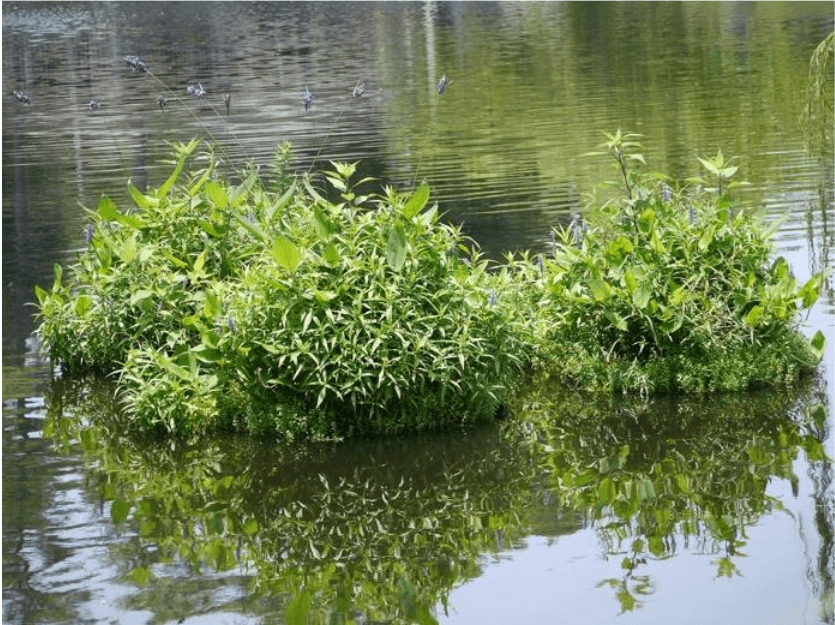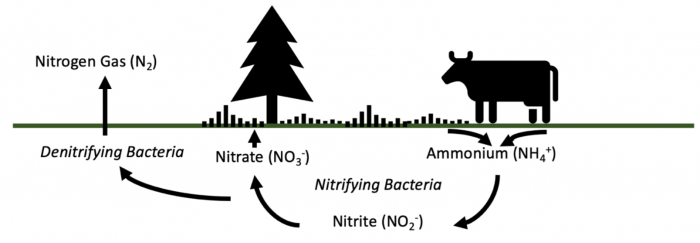
Water availability and supply dynamics are issues of great concern to society. Water quality also influences water availability dynamics because we want to ensure the water we have is clean and safe for use or reuse. Water quality has been in the spotlight recently because of incidents in Flint, MI, and city-wide boil notices in prominent cities such as Austin, TX, and Atlanta, GA. Large scale algal blooms, like those in the coastal waters of Florida, the Chesapeake Bay, and Lake Erie, can cause a cascade of negative environmental impacts, from decreased oxygen availability within the water to large scale fish kills. Algal blooms are directly linked to the amount of nutrients, specifically nitrogen and phosphorus, found within the water. Therefore, regulate or remove the nutrients; stop the algal blooms; increase water quality.
Constructed wetlands are one solution to mitigate the nutrient pollution of our waterways; they work by mimicking the natural filtration and cleansing properties of naturally occurring wetlands. In particular, floating treatment wetlands (FTWs) are a promising type of constructed wetlands for nutrient remediation within water bodies. Floating treatment wetlands are modeled on naturally floating reed beds that break away from the shoreline. These systems employ a buoyant structure, such as a mat or raft, to support plant life, with the vegetative shoot of the plant suspended above the water line and the roots exposed directly to the water. For those familiar with hydroponics, the concept is similar. By allowing roots access directly to the water, the plants work to remove excess nitrogen and phosphorus during their natural growth processes.
FTWs have been deployed in many different water systems, from harbors to rivers, lakes, and in retention ponds. Previous research has shown other types of constructed wetlands have benefited from the addition of aeration to the water source, promoting water mixing, plant growth and nutrient uptake (Bowmer, 1987; Maltais-Landry et al., 2007, 2009; Zhang et al., 2010). However, FTWs function very differently from other constructed wetlands due to the lack of soil or substrate. Would the addition of aeration in FTW systems prove to be beneficial? What if the local community wanted to add a water fountain to the retention pond? Would it hurt the efficacy of the FTWs?
To better understand why aeration is actually a big deal, there is this little natural system called the nitrogen cycle. Remember it? Cows poop. Poop is broken down and becomes ammonium. Ammonium is transformed into nitrite. Nitrite becomes nitrate. Plants take up nitrate. Cows eat plants. What is important about this system is that the transformation from ammonium to nitrite and from nitrite to nitrate is performed solely by nitrifying bacteria. To survive, these bacteria require oxygen to be present in the water, called aerobic conditions. If oxygen levels drop too low, the system is considered anaerobic (without oxygen) and the nitrogen cycle shifts into producing nitrogen gas instead. Nitrogen gas is released into the atmosphere and is not consumable by plants, reducing access to nitrogen by the plants.

Image courtesy Sarah White and Lauren Garcia Chance
For our study, we exposed one set of FTWs to an aquarium bubbler to introduce oxygen into the system, while in the other FTW set we provided no additional source of oxygen. In the absence of aeration, oxygen levels were maintained above 2 mg/L, but when aerated, the average oxygen level was above 7 mg/L. Despite differences in oxygen concentrations between non-aerated and aerated systems, the concentration of oxygen in non-aerated systems never declined to <1 mg/L or, in other words, never became anaerobic. While reaching anaerobic conditions is possible in other forms of constructed wetlands (Butterworth et al., 2013; Fan et al., 2013), FTWs permit gas exchange across the water surface and maintain acceptable aeration levels for nitrification processes without additional artificial aeration.
In other studies, the addition of aeration has helped constructed wetlands to remain aerobic and therefore increased the production of nitrate, which the plants can then take up and remove from the water. We found similar results when using FTWs; plants exposed to aeration had a greater amount of nitrogen within the plant tissues compared to those with no aeration. However, when looking at overall remediation of nutrients within the water column, a different story emerged; the non-aerated systems were actually more efficient at removing nitrogen. So, if the non-aerated systems were removing more nitrogen than the aerated, but less nitrogen was ending up in the plants, where was it going?
Following a period of head scratching, we returned to the data and found two plausible reasons. The first solution is straight forward, weeds. While we tried to remove and prevent weeds from growing on our FTWs, as any gardener knows, sometimes you lose the battle. By assessing the number of weeds and level of nutrients contained within the weeds, we found that we had higher weed presence in the non-aerated FTWs which contributed some minor fraction of nitrogen removal from the system. However, this was accounting only for those weeds that survived our killing gauntlet. Weeds removed throughout the experiment would have also accounted for some level of nitrogen removal from the system as well.
The second reason is linked to dissolved organic carbon (DOC) or the amount of carbon available within the system. Contributors to DOC could include decaying organic matter, algae, and metabolites released from plant roots systems. When assessing the amount of DOC in each system, aerated and non-aerated, we found that the non-aerated systems had 30% more DOC than the aerated systems. This is important because DOC can function as a nutrient sink, meaning nitrogen would be sorbed by this organic matter and removed from the water column. Furthermore, high DOC can actually work to encourage denitrification processes despite not reaching anaerobic conditions. Therefore, nitrogen loss from the non-aerated systems could be in the form of nitrogen gas, despite the high oxygen levels.
Ultimately, it seems FTWs are effective under both aerated and non-aerated conditions. However, the form of removal of nitrogen from the system varies, with system plant removal as the main process for aerated systems and weeds, DOC sorption, and possible release of nitrogen gas as the main processes in non-aerated conditions. Both systems help to increase water quality and help ensure a future in which clean surface water is a possibility.









